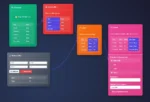
by tyler garrett | May 10, 2025 | Solutions
In the rapidly evolving landscape of data analytics and business intelligence, organizations often face the daunting challenge of classifying data amidst limited labeled examples. When datasets are vast yet labeled data remains scarce, traditional machine learning approaches may stumble, unable to fully leverage available resources. Enter transductive transfer learning—a strategic approach designed to alleviate the challenges posed by label scarcity. Rather than relying purely on labeled data, this innovative pathway harnesses unlabeled examples to bolster the effectiveness of classification tasks. In this article, we will unpack how transductive transfer learning empowers organizations to unlock significant value from sparse labels, streamline analytics workflows, and align technical efforts with strategic business objectives. As leading technologists in the realm of data-driven innovation, we aim to demystify these emerging methodologies, clarifying how your business can capitalize on the intersection between innovation, data analytics, and robust classification approaches.
Understanding Transductive Transfer Learning and Its Strategic Advantages
Transductive transfer learning is a specialized subset within the broader field of transfer learning, distinctly characterized by its focus on predicting labels specifically for a predefined set of unlabeled target data. Unlike inductive methods, which learn generalizable models for future unseen data points, transductive methods emphasize the accurate classification of the specific data available at hand. This nuanced focus can significantly enhance model accuracy in scenarios where labeled samples are limited. By leveraging the inherent structure present in unlabeled instances, transductive methods provide an edge that traditional learning approaches often struggle to achieve.
This strategic advantage unfolds when an organization has accumulated substantial unlabeled data that can inform the decision boundary more precisely than labels alone. For instance, an enterprise might obtain extensive sensor data or customer interaction logs but have limited resources to manually label each data point. Transductive transfer learning allows the business to effectively harness these datasets, extracting salient patterns to improve analytical judgments with minimal labeling overhead.
A well-executed transductive strategy aligns neatly with strategic goals for effective decision-making—identifying critical insights even in the absence of fully labeled datasets. This paradigm shift enables businesses to swiftly adapt to evolving market conditions by deploying quick yet powerful analytical approaches without significant incremental investment. It underscores the crucial role that modern, agile analytics approaches (discussed further in our quick API consulting engagements) can play in today’s competitive environment.
Leveraging Unlabeled Data: A Goldmine Waiting for Discovery
In most organizations, unlabeled data sits idle in expansive data warehouses, unused to its full potential. Organizations that understand how to creatively leverage unlabeled data for transductive transfer learning stand to realize tremendous competitive advantages. Data repositories, typically assembled and maintained through rigorous data warehousing (consulting services) processes, provide a strong foundation for this technique.
Imagine having thousands of terabytes of customer interaction points, product usage data, or market signal data. Labeling these massive data pools manually is unfeasible both from a financial and operational standpoint. By utilizing transductive transfer learning, organizations can mine these huge volumes of unlabeled data to teach algorithms, significantly reducing the labeling effort necessary to produce actionable insights. Through consistent and strategic use of transductive methodologies, data-driven organizations can better categorize customers, predict behaviors, and target interventions effectively.
Moreover, advancements in analytical hierarchies such as recursive materialized view patterns have enabled sophisticated management and extraction of valuable insights. Combined with transductive learning, these modern data patterns help businesses fully exploit unlabeled data streams. Recognizing that your existing unlabeled data pools are latent goldmines of potential insights—that is the first step towards transformative outcomes with a minimal upfront labeling cost.
The Technical Anatomy of Effective Transductive Learning Models
Deploying a transductive transfer learning solution requires a clear understanding of its foundational technical components. At its core, transductive learning involves simultaneously leveraging labeled and unlabeled data to construct robust decision boundaries. Key mechanisms such as semi-supervised learning, manifold regularization, and graph-based approaches collectively form the pillars of this methodology.
Semi-supervised algorithms use limited labeled examples alongside extensive unlabeled examples, enabling superior generalization and predictive accuracy without excessively labeled datasets. Similarly, higher-dimensional data representations using quaternion-based visualizations are compelling tools to reveal subtle structure inherent in unlabeled datasets. Manifold regularization methods further improve the robustness of decision boundaries by imposing smoothness constraints across data points lying on an underlying low-dimensional structure embedded within the high-dimensional input space.
Graph-based learning approaches also significantly contribute by leveraging the natural relationships encapsulated within the data, translating proximity in feature space into meaningful classifications across unlabeled samples. Combined, these technical methodologies form the indispensable anatomy of an effective transductive transfer learning approach. They offer enterprise-level scalability, robustness, and clarity—qualities inherent to any high-performing data pipeline designed for reliability and maintainability.
Putting Transductive Transfer Learning into Action
Moving beyond the theoretical foundations, practical implementation is pivotal. For professionals and leaders, selecting the right infrastructure and tools is crucial. Begin by clearly defining a data contract through a coherent datacontract-driven development process, ensuring different teams across your organization are aligned around data definitions, meaning, and quality standards.
Next, create an environment conducive to accelerating computations. Vectorized query processing techniques, which significantly optimize computations on large datasets, can streamline training and inference tasks in transductive models. Additionally, employing robust data transfer solutions—such as setting up automated processes to stream data directly to analysis platforms—ensures the smooth integration of fresh and relevant data over time.
Finally, creating visual feedback systems with intuitive analytics tools like Tableau (for comprehensive guidance, see our tutorial on how to install Tableau Desktop) allows organizations to clearly monitor classification performance metrics and value-add insights derived from transductive learning approaches. Organizations that effectively operationalize this strategic analytics approach can react more nimbly to shifting market dynamics and sustain lasting competitive advantages from minimal labeled data.
Overcoming Challenges and Maximizing Results
No technical solution comes without challenges. One prominent obstacle is the careful tuning required to balance labeled and unlabeled data effectively, ensuring the model leverages each efficiently. Selecting the appropriate semi-supervised methodology or graph-based model requires meticulous decision-making and expert analysis to guarantee robust results. Engaging skilled data professionals and strategic consulting partners experienced in advanced data classification methods is thus ideal for overcoming these implementation hurdles.
Equally critical is maintaining an emphasis on transparency and interpretability within your models. Decision-makers need interpretability to make impactful strategic choices; leveraging explainable machine learning methods ensures comprehensive, intuitive insights. By combining strategic advisory from technology partners well-versed in analytics innovation, such as our consulting firm, your enterprise is empowered to unlock meaningful outcomes from transductive transfer learning.
Organizations willing to strategically tackle these obstacles and creatively navigate complexity with continuous optimization efforts are poised to optimize value extraction from sparse labels. Doing so enables rapid insights, sharper predictions, and smart allocation of analytic resources.
Conclusion: Charting a Course Towards Smarter Data Classification
Transductive transfer learning represents more than a passing analytics trend. Rather, it strategically addresses today’s analytics challenge of limited labeled data availability by smartly harnessing unlabeled data sources. Organizations keen on extracting maximal insights from their substantial unlabeled data repositories can harness transductive methodologies to deliver powerful analytical outcomes without prohibitive labeling costs.
As leading experts in data, analytics, and innovation, we encourage forward-thinking executives and decision-makers to recognize the competitive advantages afforded by strategic transductive transfer learning. Embracing this approach will empower organizations to streamline workloads, bolster analytical agility, and significantly reduce labeling overhead—truly elevating organizations to greater analytical insights and market responsiveness.

by tyler garrett | May 10, 2025 | Solutions
Master Data Management (MDM) has become a critical cornerstone of organizations aiming to harness their data’s true potential. However, the complexity of data sources, varied naming conventions, and inaccuracies make MDM challenging, particularly when standard matching methods fall short. Enter fuzzy entity resolution, a powerful approach to matching and deduplicating data even when exact matches don’t exist. By employing advanced techniques like fuzzy logic and probabilistic matching, fuzzy entity resolution allows enterprises to dramatically enhance their data accuracy, consistency, and overall quality. In this article, we’ll explore the crucial role these fuzzy methodologies play within master data management strategies, how they help overcome difficult data problems, and the specific tactics that you—as a decision-maker—can adopt for a strategic business advantage through decisive and informed approaches to data.
Why Fuzzy Entity Resolution Matters in Master Data Management (MDM)
Master data management seeks to maintain consistent, accurate, and reliable data across organizational systems. However, data inconsistencies frequently arise, stemming from manual data entry errors, varied naming conventions, or system interoperability issues. Traditional entity resolution techniques relying solely on exact matches struggle under these conditions, leading to fragmented and duplicated datasets. This issue impacts decision-making, productivity, and efficiency, weakening the organization’s ability to lean on analytics systems confidently.
Employing fuzzy entity resolution elevates your data quality by intelligently addressing variations or inaccuracies. Unlike conventional lookup approaches, fuzzy matching handles approximate matches effectively, identifying and consolidating entities despite differences or errors. For instance, “Jon Smith,” “Jonathan Smith,” and “J Smith” can all be resolved to one identity confidently, stepping away from rigid exact-match constraints.
Adopting fuzzy entity resolution methods directly aligns with your organization’s analytics strategy. Remarkably, improved master data transforms downstream analytics processes and visualizations. High-quality data accuracy supports effective analytics, helping you achieve reliable and trustworthy visualizations, a topic we’ve emphasized deeply in our previous article on collecting and cleaning your data. Thus, incorporating fuzzy techniques in MDM is not just good practice, but crucial for maintaining strategic data integrity.
The Principles Behind Fuzzy Matching and Resolution
Fuzzy entity resolution relies on techniques that tolerate uncertainty and approximate matches rather than binary yes/no patterns. The goal is to quantify data similarity through robust mathematical algorithms. One prevalent method is the Levenshtein distance or edit distance measurement, which quantifies string similarity by tracking the minimal edits required to transform one string into another. For example, it accurately captures variations in names, addresses, or product titles, bringing clarity and coherence from ambiguous records.
Another powerful fuzzy matching approach is probabilistic matching. Probabilistic approaches evaluate data based on specific thresholds and consider confidence levels rather than exact matches—the algorithm assigns entity matches using defined probabilities determined through ML models, rules, or heuristics. The effectiveness of probabilistic techniques dramatically expands MDM reliability because the resulting dataset reflects adjustments for real-world nuance and discrepancies.
The foundational understanding behind fuzzy resolution techniques strongly resonates with broader data management principles. We’ve touched upon related concepts previously in our detailed exploration of improving data efficiency by leveraging relational theory and normalization. In essence, fuzzy matching is a strategic complement to traditional database normalization methods, promoting cleaner data ecosystems and enabling smarter, healthier decision-making environments.
Implementing Fuzzy Techniques Effectively in Your Data Strategy
A strategic adoption of fuzzy entity resolution requires careful consideration of business needs, data availability, data volume, and resource allocation expertise. Begin by comprehensively understanding your organization’s specific data challenges—whether your business suffers from customer data duplicates, inconsistent product categorization, or fragmented supplier records. Only then can you select the most suitable matching algorithm, customize accuracy thresholds, and integrate enrichment services effectively.
Effective implementation typically involves establishing an optimized data pipeline for seamless integration of fuzzy matching capabilities. To ensure agility and scalable workflows, we recommend leveraging a robust continuous integration and continuous deployment (CI/CD) pipeline. Read our extensive insights from the article on building your CI/CD pipeline, where we emphasize streamlined, efficient deployments aligned with strategic data objectives—essential for the rapid integration of fuzzy entity resolution techniques.
Another foundational consideration revolves around efficiently setting up your underlying databases. Depending on whether you use MySQL, PostgreSQL, or other relational database solutions, appropriate installation and optimization can significantly enhance your fuzzy matching performance. Our guides on database installation—for instance, this detailed instruction on how to install MySQL on Mac or our professional PostgreSQL consulting services—ensure your data infrastructure is optimized and ready to efficiently integrate fuzzy matching strategies.
Leveraging APIs and Automation in Your Fuzzy MDM Implementation
APIs (application programming interfaces) provide flexible and modular interfaces for incorporating advanced fuzzy entity resolution via third-party or internal solutions, elevating scalability and efficiency. Strategically leveraging APIs enables your organization to automate entity resolution directly within your master data pipelines—vastly reducing manual effort and response time. An intelligently designed, API-driven fuzzy matching architecture effortlessly complements your overall innovation strategy.
Given the importance of robust integration and efficient automation for fuzzy matching, understanding APIs thoroughly is paramount. We addressed API integration comprehensively in our ultimate API guide for everyone. By harnessing these API-enabled integrations, your organization unlocks higher productivity, rapid data consolidation, and improved master data visibility—key achievements enabling advanced analytical capabilities and streamlined data operations.
Automation through APIs aligns well with today’s broad transformation in data management and the growing adoption of exciting emerging technologies like quantum computing. As we previously explored in our article around exploring the exciting world of quantum computing, future-ready organizations are already exploring powerful, innovative technologies to maintain competitive advantage. Fuzzy entity resolution implemented via smart APIs represents an equally strategic approach, meeting critical, immediate enterprise demands today.
Visualization and Reporting: Integrating Fuzzy MDM in Analytics Workflows
Ultimately, ensuring fuzzy entity resolution’s successes translate into effective visualization and reporting mechanisms is vital. High-quality analytics hinge upon accurate and consistent dataset outputs—a core antecedent to reliable visual storytelling. Integrating fuzzy matching results directly into analytics and reporting workflows ensures consistent insights, robust KPIs, and highly relevant business intelligence.
Organizations can further boost the value of fuzzy MDM by optimizing visualizations based on clean, resolved data. For Tableau users, judicious optimization makes visualizations easier to interpret and quicker to render. As we’ve recommended in our guide on how to optimize image rendering in Tableau Desktop, consistent improvement in your reporting infrastructure contributes positively toward generating actionable insights rapidly—crucial for decision-makers always looking to stay ahead of industry trends.
Thus, leveraging successfully implemented fuzzy entity resolution enriches your broader analytics story, enhancing trustworthy and strategic data narratives. Achieving confidence in your analytics consistently requires a strategic investment in effective MDM combined with fuzzy entity resolution expertise and advanced visualization methodologies.
Conclusion: Master Your Data Future with Fuzzy Entity Resolution
At its core, fuzzy entity resolution significantly elevates your ability to handle complex, imperfect data environments confidently. By transforming possible ambiguity into clearly-defined entities, it’s no longer solely about survival amid challenging data scenarios—it’s about creating new opportunities for clarity, precision, and advantage in your market.
As consultants specializing in data intelligence, analytics, and innovation, we firmly believe that harnessing fuzzy entity resolution is essential to modern master data management strategies. From optimized database infrastructure to intelligent API integration, and from powerful fuzzy matching algorithms to seamless analytics workflows, empowering leaders starts with strategic technology deployment.
Master your data’s future by embracing fuzzy entity resolution today, positioning your organization as strategically advanced, data-driven, and innovation ready.

by tyler garrett | May 9, 2025 | Solutions
In today’s fast-paced data-driven landscape, businesses find themselves managing increasingly diverse datasets—from visual images and textual documents to complex sensor arrays and audio recordings. Understanding and extracting valuable insights require innovative strategies modern analytics demand: aligning these varied “modalities” of data into cohesive and actionable analyses. Cross-modal data alignment stands at the intersection of analytics, machine learning, and strategic data management, unlocking powerful unified views that once remained hidden in isolation. For visionary decision-makers eager to transform siloed information into strategic advantage, mastering data strategy implementation and cross-modal data alignment becomes critical for future readiness.
Understanding the Value of Cross-Modal Data Alignment
Cross-modal data refers to datasets originating from different sources or forms and encapsulating varied types of information, such as textual, audio, visual, and numerical data. Aligning cross-modal datasets empowers businesses to generate richer insights that single-modal analysis simply cannot provide. Consider the world of retail analytics: stores analyzing social media sentiment (textual data), customer foot traffic analytics (sensor data), and POS transactions (numerical data) together can holistically understand customer behavior, significantly enhancing customer experience.
Unified data alignment offers organizations near-real-time analytics and a comprehensive understanding of complex market trends. Such clarity fosters swift decision-making, drives innovation, and equips businesses to evolve more effectively within intended markets. For instance, healthcare organizations could integrate medical imaging records, audio inputs from patient interactions, and electronic medical records. The resulting unified datasets allow clinicians and researchers to discover nuanced patterns more easily, encouraging proactive and personalized patient care.
Moreover, strategically aligning multiple data types provides clarity and depth in business intelligence (BI) solutions, strengthening reporting accuracy and enabling precise forecasting. As our team has seen firsthand in Power BI consulting services, integrating multiple data sources translates directly into elevated confidence in organizational decision-making and reporting standards.
Methods for Effective Cross-Modal Data Alignment
Feature-level Alignment: Bridging the Information Gap
Feature-level alignment involves extracting meaningful identifiers or features from each modality separately before subsequently aligning them. Machine learning techniques such as dimensionality reduction, principal component analysis (PCA), and deep neural networks often underpin successful feature-level alignment methods. For instance, image features derived through convolutional neural networks (CNNs) can efficiently be paired with textual embeddings derived via natural language processing (NLP) platforms. These combined features reveal deeper collective insights, advancing industry objectives toward highly targeted analysis.
This type of data alignment has practical public safety applications as well. As highlighted in our article on fraud detection evolution, combining financial numeric data, log metadata, and textual data from user interfaces enables organizations to effectively identify anomalies and address potential fraud proactively.
Semantic Alignment: Speaking the Same Data Language
Semantic alignment ensures meaningful correlation between modalities based on contextual interpretation. Its foundation combines NLP and advanced computer vision algorithms, allowing understanding across multiple data modalities based on semantic meaning rather than simple numeric or categorical similarities. For example, aligning product reviews and customer feedback (textual data) with corresponding purchase or return history datasets (numerical data) can pinpoint not only customer behavior patterns but also motivations and emotional responses.
This unified interpretive approach proves invaluable in customer-facing scenarios or environments where sentiment analysis heavily impacts strategic decision-making, such as digital marketing and customer experience enhancement. Semantic alignment methods ensure that businesses speak the “same data language,” enabling organizations to confidently derive meaningful business value from highly varied and complex data types.
Challenges Encountered in Cross-Modal Data Alignment
Data Complexity & Volume
Aligning datasets from different modalities rarely resembles a straightforward integration—a multitude of complexities frequently emerge. Differences in size, dimensionality, feature density, noise, and quality frequently pose technical hurdles. IT leaders need to anticipate sophisticated data engineering solutions and robust analytical architectures capable of handling varied data complexities at scale. Awareness of these integration challenges helps ensure that organizations build resilient data pipelines and effective BI solutions, thereby creating scalable and future-facing infrastructure.
Additionally, visualization becomes crucial in communicating these complex data integrations. As referenced in our article highlighting the importance of data visualization in data science, understanding cross-modal data integrations is significantly advanced using robust visuals, enabling decision-makers to visualize and interpret results much more clearly.
Variability and Compatibility Issues
Ensuring interoperability among differing data systems is often troublesome as modalities like audio, images, videos, and tabular data frequently require separate database and storage setups. IT architects must thoughtfully design polyglot infrastructures capable of accommodating cross-modal data environments, utilizing polyglot persistence architectures to ensure data is stored and accessed in the most effective way. Decision-makers who proactively identify and adequately plan polyglot data architecture navigate cross-modal challenges with success, translating into fully aligned data sets and unified analytic insights at an organizational level.
Technologies to Facilitate Cross-Modal Alignment & Analysis
Advanced Analytics Platforms & Visualization Tools
Emerging analytics and BI platforms have dramatically simplified the process of cross-modal data alignment. Platforms like Microsoft Power BI, Tableau, or open-source visualization frameworks now integrate seamlessly, providing comprehensive alignment and interactive visualization features. These tools streamline integration and offer visual explorations necessary for multi-dimensional insights. For example, incorporating varied data visualizations such as sparkline charts—explored in-depth in our guide on creating sparkline charts using Tableau Desktop—allows businesses to present aligned data attractively and meaningfully, fostering stronger engagement and facilitating better-informed decisions.
Collaborative and Cloud-Based Data Management Systems
Cloud-based collaborative tools provide scalable, distributed computing solutions capable of efficiently coordinating and aligning varied data modalities. Leveraging managed services from AWS, Azure, or Google Cloud, organizations adopt architectures that automatically handle complex cross-modal data alignment, synchronization, and storage operations. By removing on-premise storage restrictions and enabling efficient federation of analytics across multiple modalities and data streams, cloud-based offerings pave the way for rapid, secure, accessible analytics—removing longstanding barriers to unified analysis.
Looking Ahead: The Future of Cross-Modal Data Alignment
The future of cross-modal data alignment is rich in possibility, influenced by increasing adoption of multivariate analysis techniques and advanced Artificial Intelligence solutions, like multi-modal neural networks. Industry trends suggest continued innovation in feature extraction, embedding enhancements—such as transformer models capable of unified, multi-modal embeddings—and streamlined alignment algorithms that automate previously cumbersome and manual integrations.
This emerging frontier of analytics will not tolerate outdated or poorly structured data lakes but instead demand structured, well-governed, and efficient data systems capable of rapid integration and deployment for precise analytic results. Organizations intending to maintain market agility and industry leadership must prioritize mastering cross-modal data capabilities today, ensuring they lead the future, not lag behind the analytics competition.
As technology leaders, executives, and stakeholders, seizing this opportunity means breaking down traditional organizational silos and embracing collaborative digital cultures. Building effective cross-functional teams through intentional networking with data science professionals can catalyze these powerful analytical transformations, enabling your organization to proactively drive innovation rather than reactively follow industry trends.

by tyler garrett | May 8, 2025 | Solutions
In today’s data-driven business environment, efficiency means the difference between industry leaders setting the pace and those left behind. Executives, strategists, and technical experts alike require rapid insight into vast volumes of data—you simply can’t afford delays in processing critical queries. This is precisely why businesses are strategically turning toward vectorized query processing tools and methods. Leveraging advanced vectorization techniques upgrades your data analysis from “just functional” to “lightspeed,” transforming business decisions in real-time. Ready to empower data-driven decisions and drive competitive advantage? Let’s explore how vectorized query processing helps organizations accelerate their data workflows and build a truly efficient data-driven culture.
Understanding Vectorized Query Processing: A Quick Primer
Vectorized query processing is a cutting-edge data processing technique designed to enhance the speed and efficiency of database queries. Traditional query engines process one data item at a time—a technique known as row-wise processing—often resulting in inefficient utilization of modern hardware resources. In contrast, vectorized engines process entire batches (vectors) of data in parallel, capitalizing on current CPU architectures that handle multiple operations simultaneously.
How does this work exactly? By organizing query operations into high-performance, parallelizable batches, vectorized processing significantly reduces CPU overhead and eliminates unnecessary repetition, allowing you to process queries more efficiently. These batches of data points, or vectors, benefit from reduced CPU instructions (fewer conditional branches, better cache utilization) and optimized memory usage. This streamlined approach can dramatically accelerate performance, particularly in analyzing substantial volumes of structured data.
For data-driven organizations seeking a competitive edge, embracing vectorized query practices enables quicker, almost real-time processing, thus contributing directly to precise decision-making, enhanced forecasting accuracy—as outlined in our recent piece on accurate demand prediction—and optimized resource allocation strategies.
Benefits of Implementing a Vectorized Query Strategy in Your Organization
Faster Queries, Smarter Decisions
The essential benefit of vectorized query processing lies in its immense speed gains over traditional methods. Where legacy query architectures become bogged down with large-scale datasets, vectorized processing consistently outpaces them, reducing query times from hours down to mere seconds or minutes. This speed enhancement translates directly into strategic agility—giving your business the rapid insights necessary for quicker decision-making and a stronger competitive posture. For those eager to dive deep and explore further performance optimization and real-time insights, our recent guide on microservice telemetry aggregation patterns can offer complementary strategies for maximizing speed and efficiency.
Maximizing Hardware Utilization
Today’s hardware landscapes are optimized for parallelized task execution, from vector units in modern CPUs to multicore processors and GPU acceleration. Vectorized query engines are specifically crafted to exploit hardware capabilities thoroughly. By converting queries and operations into highly-efficient, parallelizable instructions, vectorized processing ensures maximal hardware utilization, dramatically improving throughput and lowering overall data processing costs. The outcome is straightforward: more efficient use of existing resources, reduced infrastructure overhead, and lowered IT expenses, supporting businesses striving toward cost-effective scalability. To better understand such architectures, check out our perspective on why many data engineers misunderstand scaling architectures.
Ensuring Accurate Analytics and Forecasting
Vectorized processing doesn’t only deliver speed. Its highly-structured, repeatable processes also significantly reduce processing errors, providing consistent and accurate results across vast datasets. As accuracy in data analytics directly translates into better forecasting and resource allocation, it’s an essential tool for organizations pursuing ambitious analytical and operational excellence initiatives. Leveraging vectorized query processing within analytics enhances predictive modeling capabilities—exactly why it’s important to understand the benefits outlined in our article on streamlined production planning for improved resource allocation.
Practical Use Cases: Where Vectorized Query Processing Shines
Wondering if vectorized query processing is relevant in your organization’s context? The applications for this transformative technology cut across industries—from finance to healthcare and manufacturing. Consider the healthcare industry, for instance. Complex analysis of patient data, including lab results and electronic health records, becomes significantly faster, facilitating timely diagnoses, personalized treatment plans, and real-time analytics. Our exploration of how data analytics transforms healthcare clearly highlights broader real-world implementations and the power behind accelerated data handling in critical settings.
Similarly, finance and retail sectors benefit substantially from vectorized query processing. Quick processing enables precise financial modeling, real-time fraud detection, and instant market analyses—vital for sound strategic decisions in highly competitive environments. Furthermore, manufacturers can continuously optimize their production lines by accessing insights faster, utilizing smarter performance metrics, and proactively identifying and reducing wastage or bottlenecks in production.
Across industries, the relevance and application of powerful query acceleration through vectorization become crucially clear: speed matters, and the ability to rapidly harness critical insights fundamentally reshapes a company’s operational effectiveness.
Beyond Traditional Data Processing: Vectorized Querying Alongside Emerging Technologies
Vectorized query processing fits neatly into the advancing landscape of technology that’s transforming data manipulation at a fundamental level. Going beyond standard data processing methodologies, companies are confidently navigating toward sophisticated new innovations. One innovation we recently spotlighted is quantum computing, detailed in our forward-looking piece on how quantum computing is set to transform the data industry. Combined thoughtfully, vectorization and quantum computing represent complementary pieces of a sophisticated puzzle designed to amplify data analytics to unprecedented scales.
In parallel, technologies such as NodeJS-based back-end architectures are becoming popular choices for efficiently scalable data processing and real-time analytic systems. Businesses interested in understanding how this modern back-end technology integrates seamlessly into their data ecosystem can explore our expert-focused NodeJS consulting services. By effectively pairing powerful query engine capabilities alongside emerging technologies, businesses can future-proof their analytical capabilities, fully embracing innovative and transformative approaches to data utilization.
Getting Started with Vectorized Query Processing: Recommendations for Success
If your organization is exploring vectorized processing to drive data workloads at warp speed, careful planning and strategy alignment remain critical. Decision-makers should focus on assessing their current infrastructure, identifying business areas that stand to benefit most, and gradually adopting vectorized technology while carefully tracking KPIs and expected outcomes.
A successful implementation begins with informed decision-making—making a genuine assessment of your organization’s readiness for vectorized processing, equipping your teams with the necessary education and resources, then incrementally incorporating new technology into your existing ecosystem. Additionally, businesses must pay close attention to user adoption and make sure the reports and data insights they provide are truly meaningful—that is, ensuring you’re not making the costly mistake outlined in our cautionary post, “No one looks at your reports? Ouch!”.
Taking advantage of vectorized query processing doesn’t just involve incorporating advanced computing techniques and cutting-edge technology. Rather, it represents a vital step toward a cohesive strategy that intertwines technology, talent, and organizational culture, ensuring lasting digital transformation and sustainable data leadership.
Ready to scale your data performance and embrace revolutionary query acceleration strategies? Begin by rethinking your data culture, investing in appropriate technologies, and ultimately integrating vectorized query processing strategies into your broader digital and data ecosystem.

by tyler garrett | May 8, 2025 | Solutions
In the rapidly evolving landscape of data analytics and business intelligence, understanding how your data travels through various systems and transformations has become mission-critical. Graph-based data lineage visualization empowers you to trace data from its origin to its final destination, providing unparalleled clarity into complex workflows and integrations. Equipped with insights derived from these visual maps, businesses can better manage their data processes, anticipate disruptions, ensure compliance, and build stronger datasets to drive strategic decision-making. If your enterprise values data-driven innovation, optimizing your approach to lineage visualization can unlock significant competitive advantages.
The Importance of Data Lineage in Today’s Data-Driven World
Today, enterprises are generating and processing massive volumes of data at breakneck speed. Data lineage—defined as the lifecycle journey data undergoes from its creation or acquisition through multiple transformations—is no longer optional but essential. Precise lineage details provide stakeholders clarity about data origins, transformations, and dependencies. Without such visibility, organizations risk costly compliance violations, misinformed analytics, and flawed business initiatives. Just as database administrators know the necessity of managing access control in SQL, maintaining detailed lineage documentation prevents unauthorized modifications and enhances operational oversight.
A proactive approach to data lineage provides executives and analysts the confidence to rely on their analytics outcomes. This strategy promotes higher levels of transparency, especially critical as data privacy laws and regulatory audits become more stringent. Remember that a robust lineage visualization approach doesn’t merely represent data streams; it helps decision-makers uncover hidden bottlenecks, duplicate processes, and unnecessary complexities. An effective lineage implementation ensures your organization stays agile, responsive, and secure—qualities essential for thriving in today’s high-speed digital economy.
Leveraging Graph-Based Approaches for Effective Lineage Visualization
Traditional data lineage often utilizes documentation methods such as spreadsheets or static diagrams. However, these methods quickly become unwieldy when confronting complex data ecosystems. Graph-based visualizations transform data lineage from static documents into dynamic, interactive maps, greatly enhancing readability and usability. This structured visualization supports faster, more confident decision-making, providing clarity around the dependencies between various databases, analytical frameworks, and integration touchpoints.
Graph databases like Neo4j or open-source solutions leveraging PostgreSQL have emerged as powerful engines for lineage visualization due to their ability to efficiently store and query complex relationships. Leveraging advanced database tools such as PostgreSQL can empower teams to build robust graph data structures that facilitate extensive lineage analyses. Powerful database management requires specialized expertise; partnering with experienced professionals, like those found in our PostgreSQL consulting services, can accelerate successful integration of graph-based lineage solutions into your analytics frameworks.
Adopting graph-based techniques makes lineage data accessible, actionable, and integrated with advanced analysis tools and processes. Monitoring data lineage visually makes traceability intuitive for decision-makers, allowing them to directly identify business value and risks from specific data sources, transformations, and target analytics. This transparency helps ensure analytics users trust underlying data and better understand the nuances communicated through complex workflows represented visually.
Understanding and Constructing Effective Data Lineage Graphs
To successfully map data lineage using graphs, businesses first need clear definitions of nodes and relationships. Nodes represent distinct elements like datasets, databases, structures, ETL/ELT jobs, users, or applications. Edges—or connecting lines—define the type of relationship between these elements, like “extracts,” “transforms,” or “loads” data between sources and targets. Careful design of graphs ensures analysts and data managers effortlessly track information from extraction through refinement, transformation, and eventual presentation in analytics dashboards.
Effective lineage graphs aren’t merely pretty diagrams; they become integral monitoring tools that improve transparency into your organizational data pipeline. For instance, analysts can quickly identify how critical brand sentiment insights were generated in analytics dashboards—such as those described in an article we recently published about measuring brand sentiment across channels. Similarly, clarity in lineage tracking enables rapid troubleshooting when a calculation, such as those created when you write fast calculations in Tableau Desktop, goes awry.
When designing lineage graphs, employ consistency in naming conventions, node labels, edge descriptions, and metadata attributes. Aim for comprehensibility; graphs must clearly convey meaning without ambiguity. Utilizing technologies optimized for lineage visualization can enhance visual clarity and capture specific aspects of lineage relevant to your stakeholders, forming powerful visual tools to govern data strategically.
Ensuring Data Integrity through Graph-Based Lineage
Maintaining data integrity is essential in an environment where business success depends on accurate and timely analytics. Visualizing data lineage through graphs significantly enhances debugging and error tracking—catching anomalies faster, resulting in fewer downstream errors or misleading analytics. Visual lineage clarity accelerates pinpointing the root causes of errors, data quality issues, and process inefficiencies, dramatically reducing the time and resources spent trouble-shooting.
For example, if an unusual result emerges within analytics—perhaps unexpected trends in customer interactions, or mismatched brand sentiment scores—a graph-based lineage makes it immediately transparent where erroneous transformations or inaccurate data integration took place. Businesses become agile in proactively addressing data quality issues and improving processes around lineage analysis. By integrating an effective, graph-based approach to lineage as part of your analytics and data management strategy, your organization dramatically reduces fragility in downstream analytics and dashboard visualizations, such as those achieved when organizations optimize images for Tableau Desktop dashboards.
Graph lineage also fundamentally enhances accuracy and reliability by providing clear oversight into structured querying processes. Whether fixing mismatched data outputs or improving query accuracy by understanding SQL transformations, businesses benefit greatly from clear lineage strategies. This clarity extends even up to more advanced SQL techniques, like those we have detailed in our recent piece about mastering SQL pattern matching with the LIKE operator.
Unlocking Innovation Through Strategic Graph-Based Lineage Implementation
Innovative use of data lineage doesn’t just prevent data quality issues; it facilitates future business agility and innovation. With intuitive insights provided through graphical lineage visualization, stakeholders can creatively explore the art of possible within their data architecture. Businesses can evaluate alternate data integration strategies, explore system optimizations, and thoughtfully experiment with emerging big data ecosystems—topics extensively outlined in our comprehensive article on big data technology.
Graph-based lineage serves as a blueprint upon which to innovate, strategize, and align your broader digital transformation efforts. Teams gain visibility into data usage patterns across different organizational units, enabling improved alignment between diverse functional teams in analytics strategy, thus dramatically enhancing ROI and ensuring synergy of data efforts across your business.
Through this strategic visualization method, businesses can proactively anticipate data management needs, optimize resources efficiently, and deliver analytics that directly inform and enhance executive decision-making processes. Moreover, as businesses continuously adopt complex cloud-based technological stacks, graph lineage visualization tools become central to effectively integrating these solutions smoothly into enterprise architectures. In essence, adopting graph-based lineage visualization is nothing short of investing in your organization’s innovation potential and future flexibility.
Conclusion: Build Confidence and Clarity with Graph-Based Lineage
By utilizing modern graph visualizations, data lineage transforms from a compliance-driven exercise into a strategic differentiator. Integrating graph-based lineage visualization empowers stakeholders with unprecedented clarity around data origins and transformations, enabling quicker action, reduced risks, optimized analytics, and driving stronger, more aligned decision-making. As data-driven organizations scale, evolve and innovate, well-implemented lineage visualization catalyzes these transformations by elevating data-driven confidence throughout organizational ranks.
If you’re striving for greater insights, control, and operational excellence in your data analytics ecosystem—a graph-based approach to data lineage visualization should become a foundational element of your analytics architecture and your path forward.























